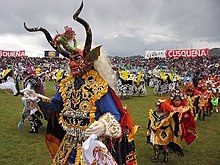| Revision as of 22:05, 1 September 2009 edit68.100.209.15 (talk)No edit summary← Previous edit | Revision as of 22:14, 1 September 2009 edit undo68.100.209.15 (talk)No edit summaryNext edit → | ||
| Line 7: | Line 7: | ||
| The oldest ''Diablada'' is recorded to have taken place on ] it's a huge parade that tells an story of the devils coming out of the mines and vow to the Virgin Mary. | The oldest ''Diablada'' is recorded to have taken place on ] it's a huge parade that tells an story of the devils coming out of the mines and vow to the Virgin Mary. | ||
| The social facts that developed this dance are unique in the Bolivian environment, Bolivian highlands are very isolated and the population's distraction is to dance, there are other dances that follow the Diablada dance in 's carnival. | |||
| The ''Diablada'' caused a reform in the thinking of the indigenous Altiplano cultures as missionaries from Spain, instilled the paradigm of good and evil, which is how the costumes of angels and demons became associated with the dance. | |||
| The Diablada dance is a mix between European Catholicism and Bolivian social facts. As a landlocked nation, Bolivia is home of predominant authentic traditions. | |||
| The Social and Racial mix between Bolivian natives and Spanish Culture has lead the dance to develop such and exiting experience. | |||
| ==Miss universe dispute== | ==Miss universe dispute== | ||
Revision as of 22:14, 1 September 2009


The Diablada is a South American dance that was created in the Andean Altiplano but holds auto sacramental origins in Spain. The dance is practised throughout the Andean region, and is an important part of the cultural festivities of the nation of Bolivia. The dance stands prominent during the Carnaval de Oruro in Bolivia. However, the dance has been incorporated very recently in some other countries
The oldest Diablada is recorded to have taken place on Oruro's carnival it's a huge parade that tells an story of the devils coming out of the mines and vow to the Virgin Mary.
The social facts that developed this dance are unique in the Bolivian environment, Bolivian highlands are very isolated and the population's distraction is to dance, there are other dances that follow the Diablada dance in 's carnival.
The Diablada dance is a mix between European Catholicism and Bolivian social facts. As a landlocked nation, Bolivia is home of predominant authentic traditions.
The Social and Racial mix between Bolivian natives and Spanish Culture has lead the dance to develop such and exiting experience.
Miss universe dispute
In August 1 of 2009 Bolivian officials stated that it could present a legal appeal to the organizers of Miss Universe due to the planned use of a typical Diablada wear by the Peruvian candidate Karen Schwarz. Pablo Groux, Bolivian minister of Culture, said that any use of the wear by Scharwz in the content would be an unlawful appropriation of Bolivian heritage and have menaced to bring the case to the International Court of Justice. El Comercio, a Peruvian newspaper, have mentioned that this is not the first time the diablada wear is shown in the contest and that it was María Josefa Isensee, a Chilean, that first used it in the Miss Universe contest. Peruvian foreign minister José Antonio García Belaúnde said that since the Diablada dress is of indigenous Aymara origin it can not be considered an exclusive of any of the particular countries where the Aymara live.
See Also
References
- Perú y Bolivia incluyen a Chile en disputa por traje de Diablada El Mercurio
- Bolivia rechaza que representante peruana en Miss Universo use traje de la "Diablada" El Mercurio
External links
This dance-related article is a stub. You can help Misplaced Pages by expanding it. |